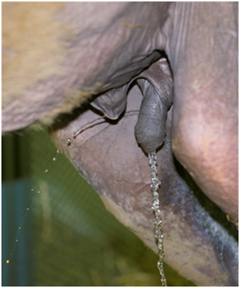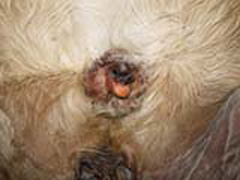
The urachus is the tube within the umbilical cord through which urine from the unborn foal travels from the bladder to the allantois (a fluid filled sac surrounding the unborn foal). Normally, the urachus closes at the time of birth and the navel dries and shrivels up within hours of birth. When the urachus does not close (persistent urachus), or closes and re-opens at a later date (patent urachus), urine continues to leak from the umbilicus. The amount of leaking urine varies considerably, ranging from an occasional drip and a moist navel, to full streams of urine.

It has been suggested that partial twisting of the umbilical cord in the womb, or a greater than average umbilical length, may lead to dilation of the urachal tube and subsequent failure to close at birth. A patent urachus can also be acquired within the first few weeks of life, even after the urachus originally appeared to have sealed at birth. This is especially common in foals that spend longer than usual periods of time laying down, therefore making debilitated and systemically ill foals most at risk for developing a patent urachus. This type of patent urachus is most commonly associated with a navel infection.
Early signs of infection may include an enlarged navel that is painful to the touch and purulent discharge from the navel opening. Navel infections can easily spread through the bloodstream causing:
- fever
- depression
- loss of appetite
- signs of serious systemic illness such as:
- respiratory difficulty
- lameness
- swollen joints
Patent urachus can also be caused by the foal straining (e.g. in the case of constipation) or potentially by lifting the foal up under the abdomen.
Call your primary care veterinarian to evaluate your foal if:
- urine is observed leaking from the navel
- you can see/feel moisture on or around the fur surrounding the navel
- enlargement of the naval
Your veterinarian will recommend a thorough examination of the foal to check for signs of systemic infection. They may perform an ultrasound examination of the foal’s navel or send you to a referral clinic to have this performed. The ultrasound examination will help confirm communication between the bladder and the urachus and help determine the presence and extent of infection. Blood work may be performed to help rule out infection, but if infection is present, bacterial cultures of the navel and or blood cultures may be performed to determine which bacteria is causing the infection to help decide on the appropriate antibiotic choice for the foal.
Navel infections can become life threatening if immediate action is not taken and the infection is allowed to spread through the bloodstream. Treatment decisions will be made with your veterinarian or board-certified veterinary surgeon and will depend on whether or not your foal has a persistent or patent urachus and whether infection is or is not present.
Persistent urachus – no abnormalities/infection
- may close on its own without treatment
- application of barrier cream around the navel to decrease urine scalding
- may require application of a chemical cauterizing agent over several days
Persistent urachus – abnormalities/infection
- surgical therapy may be recommended
- antibiotic therapy to reduce the chance of the spread of infection
Patent urachus
- antibiotic therapy
- surgical removal of the infected navel structures (thereby removing the source of further infection) and closure of the opening between the urachus and the bladder
It is impossible to prevent a foal being born with an abnormal urachus. However, to help prevent the development of a patent urachus and navel infection, it is important to:
- Closely monitor your foal’s navel in the first few weeks of life for any signs of moisture, enlargement or urine leakage.
- Dip your foal’s navel with chlorhexidine or a dilute iodine solution at the time of birth and several times over the next 24 hours.
- It is important for your foal to receive adequate colostrum to ensure that they have the required immunity to help fight infection.
- A simple blood test can be performed on your foal by your veterinarian at 24 hours of age to ensure that he/she has adequate immunity (IgG test).
- If your foal does not, plasma can be administered to the foal to help prevent the development of infection in the navel or any other part of the foal.
Mild complications of a patent urachus include:
- urine scalding of the abdominal skin surrounding the navel
- dermatitis (inflammation of the skin)
- local abscess formation.
A more serious complication of a patent urachus stems from the fact that a patent urachus provides an environment favorable for bacterial infection. This infection can spread through the bloodstream and can lead to life threatening complications such as joint infection, pneumonia and generalized septicemia. Advanced infection of the urachus or navel and involvement of other body systems greatly decreases the chance of survival. Other less common complications include bladder infection, bladder wall necrosis and abdominal adhesions.
After surgical removal, the foal will need to remain in the hospital for several days for antibiotic treatment and observation. The abdominal incision needs to be monitored daily to ensure no signs of infection are developing. Once the foal returns to the farm, they will need to remain in a clean stall with restricted activity for several weeks with controlled hand-walking thereafter. Once the abdominal incision is healed, regular activity/turnout can resume. The exact postoperative care recommendations will be provided to you by your board certified veterinary surgeon at the time of discharge from the hospital.
- The prognosis for a persistent urachus is excellent in most cases.
- The prognosis is good in cases of acquired patent urachus with associated navel infection when there is an early diagnosis and prompt medical and surgical treatment.
- Advanced infection and spread of infection through the bloodstream greatly reduces the chance of survival and the prognosis is guarded.
There are inherent risks involving general anesthesia and surgery if surgical removal of the urachus and navel is necessary. Your board certified veterinary surgeon will explain these risks in detail before performing surgery on your foal.












